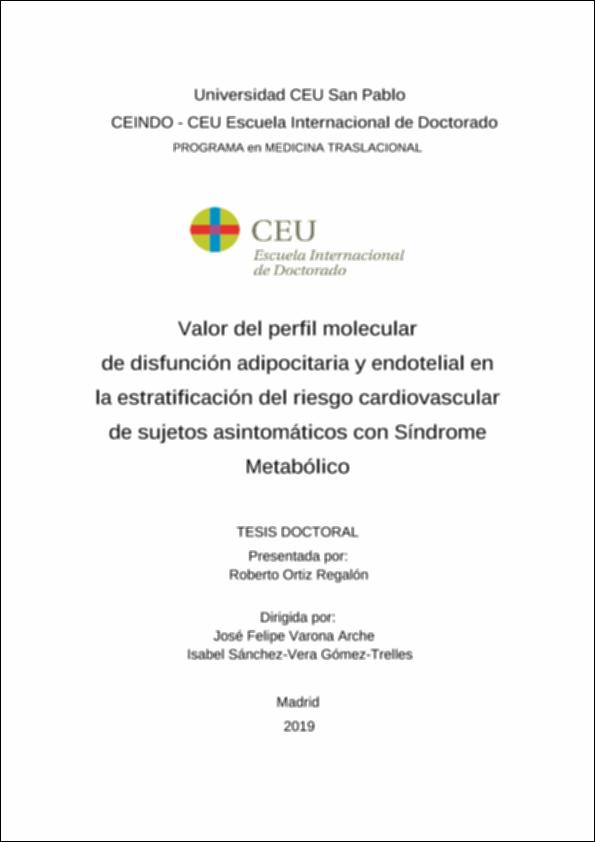Please use this identifier to cite or link to this item:
http://hdl.handle.net/10637/12300Valor del perfil molecular de disfunción adipocitaria y endotelial en la estratificación del riesgo cardiovascular de sujetos asintomáticos con síndrome metabólico.
| Title: | Valor del perfil molecular de disfunción adipocitaria y endotelial en la estratificación del riesgo cardiovascular de sujetos asintomáticos con síndrome metabólico. |
| Authors : | Ortiz Regalón, Roberto |
| Keywords: | Arterioesclerosis.; Metabolismo humano.; Patología cardiovascular.; Atherosclerotic cardiovascular disease.; Ateroesclerosis. |
| Abstract: | El objetivo es estudiar la asociación entre la aterosclerosis subclínica y la presencia
de los parámetros plasmáticos relacionados con la disfunción del adipocito y el
endotelio vascular, en sujetos no fumadores con SM, menores de 60 años y sin
eventos cardiovasculares previos. Y las conclusiones que se obtienen son que nuestros resultados objetivan que el aumento de los niveles de
ICAM-1, VCAM-1 y PAI-1 conlleva un desequilibrio proinflamatorio que se asocia
con la presencia de aterosclerosis subclínica. Por tanto, la determinación de sus
niveles plasmáticos puede ser de gran utilidad clínica y mejorar la estratificación
del riesgo de ECV en sujetos no fumadores en estadios tempranos de SM, más
allá de los marcadores tradicionales de riesgo cardiovascular. Background. Metabolic syndrome (MetS) is a heterogeneous clinical entity associated with insulin resistance, low-grade proinflammatory balance and impaired endotelial function, accelerating atherosclerosis. Atherosclerotic lesions worsen with age, smoking and co-morbidities, making it difficult to accurately diagnose the cardiovascular disease (CVD) risk. Aim. We investigate the association between subclinical atherosclerosis and the presence of blood parameters related to adipocyte and vascular endothelial cell dysfunction, in non-smokers with MetS, under 60 and without previous CVD events. Methods. Seventy-eight asymptomatic individuals (average 46.5 years, 69% male; 59 MetS and 19 controls) were studied prospectively. Subclinical CVD was defined by the presence of carotid plaque and/or carotid intima-media thickness (CIMT) O 0.9 in 2/3D ultrasound-studies, left ventricular hypertrophy (LVH) or high coronary calcium score (CCS). Multiplex immunoassay by Luminex xMAP was performed to measure plasma levels of adipokines and endothelial cellderived molecules. Results. Compared with controls, MetS patients had higher prevalence of carotid plaque (25 vs. 0%, p = 0.01), CIMT>0.9 (73 vs. 26%, p = 0.001) and higher CCS (69 vs. 5, p = 0.01), which were associated with a increase in plasma in ICAM-1, VCAM-1 and PAI-1 (p <0.05). There was a statistically significant association between CIMT and ICAM-1 (OR: 14.57, 95% CI: 2.56-82.73, p<0.001), VCAM-1 (OR:7.33, 95% CI: 1,58-33.96, p = 0.007) and PAI-1 (OR:7.80, 95% CI: 1.04- 22.10, p = 0.036) in patients with carotid plaque and/or CIMT>0.9. Positive correlation between plaque volume and ICAM-1 levels was also detected (r = 0.40, p = 0.045). Conclusions. We demonstrated that the increase of ICAM-1, VCAM-1 and PAI1 led to a proinflammatory imbalance pointing to the presence of subclinical atherosclerosis, and improving CVD risk stratification in non-smoking patients at early stage MetS beyond traditional scores. |
| Description: | Tesis-CEINDO, Universidad San Pablo CEU, Programa en Medicina Traslacional, leida 29 mayo de 2020 |
| Director(s): | Varona Arche, José Felipe |
| URI: | http://hdl.handle.net/10637/12300 |
| Rights : | http://creativecommons.org/licenses/by-nc-nd/4.0/deed.es |
| Issue Date: | 9-Apr-2021 |
| Center : | Universidad San Pablo-CEU |
| Appears in Collections: | Medicina Traslacional |
Items in DSpace are protected by copyright, with all rights reserved, unless otherwise indicated.


